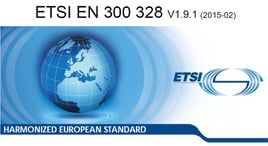Posted by Ron Tozaki, November 17, 2015
Are you prepared for EN 300 328 v1.9.1?

EN 300 328 covers wideband data systems operating in the 2.4GHz ISM band, including Wi-Fi, Bluetooth, and ZigBee. This is the harmonized standard against which manufacturers must issue their Declaration of Conformity for the Radio and Telecommunications Terminal Equipment (R&TTE) Directive.
Since there were significant changes between ETSI’s V1.7.1 and V1.8.1, it’s natural that electronics manufacturers are wondering what changes are in store for V1.9.1. The latest update, EN 300 328 V1.9.1, is now published and available to download free of charge from the ETSI website.
The overall scope and the essential requirements of the standard remain the same, but there are changes that include new and revised definitions, modifications to the limits, and simplification and clarification of test methods. Following are four important updates:
Frequency Occupation Options
For frequency hopping equipment, the requirement for Minimum Frequency Occupation was renamed to Frequency Occupation, and it now includes options for compliance.
Dwell Time Definition Change
Also for frequency hoppers, the definition of Dwell Time was clarified and the conformance requirement for Dwell Time was renamed to Accumulated Transmit Time.
Adaptivity for Non-FHSS Devices Modification
The Adaptivity conformance requirement for non-frequency hopping devices using Listen Before Talk (LBT) was modified to remove the confusing random variable ‘R’ and value ‘q.’ Instead, to simplify the test methods, the Clear Channel Assessment time and Channel Occupancy time are fixed values, or a range of fixed values.
Emissions Requirement Change
The transmitter unwanted emissions in the spurious domain and the receiver spurious emission requirements have also changed. The update includes a clarification on the requirement for both conductive and radiated measurements. The test procedures for spurious emissions were also modified and slightly better defined.
Overview of the technical differences between EN 300 328 V1.8.1 and EN 300 328 V1.9.1
|
TEST ITEM |
V1.8.1 |
V1.9.1 |
|
Transmitter |
Required to test Transmitter Unwanted Emissions in the Out‐of‐band |
It is no longer a requirement to test Transmitter Unwanted Emissions in the Out‐of‐band (Clause 5.3.9) at extreme temperatures; so this change will reduce test time. |
|
Adaptivity & Receiver Blocking |
1. CCA> 20 us , declared by Supplier 2. q= { 4 ... 32} , declare by supplier 3. R= { 1 ... q } , base on step 2 4. Extended CCA = R * CCA 5. COT < (13/32) * q, q=4...32, unit=ms 6. SCST < 5ms (observation period of 50 ms) Receiver blocking requirement: ‐30dBm |
1.CCA> 18 us 2. remove "q" and "R“ 3. Extended CCA > 18 us 4. COT < 13ms 5. SCST < 5ms (observation period of 50 ms) Receiver blocking requirement: ‐35dBm |
|
Geo-Location Capability “Capability of equipment to determine its geographical location” |
Not Defined |
New declaration required by manufacturers if Geo‐Location Capability is supported (No test requirement). If using V1.8.1 test results for V1.9.1, this will File. |
What does it mean for you?
To maintain selling your products in Europe:
- Manufacturers can continue to declare compliance to the older version, as long as it is not expired per the EU Official Journal (typically 18‐24 months for transition period).
- After the previous version is superseded (after the transition time), products cannot be certified based on the old version. This is why we recommend manufacturers to get certification based on the new version, once it is cited in OJ.
- Products certified under v1.8.1 are “grandfathered”, meaning they are valid until the end of November 2016.
Important “Cut‐In” Dates for v1.9.1
Contact Silex at sales@silexamerica.com if you have any questions regarding this latest ETSI update and how Silex plans to be in compliance after November 30th, 2016.

%20_300dpi.jpg?width=300&height=300&name=AP-800AX(2000x2000)%20_300dpi.jpg)
